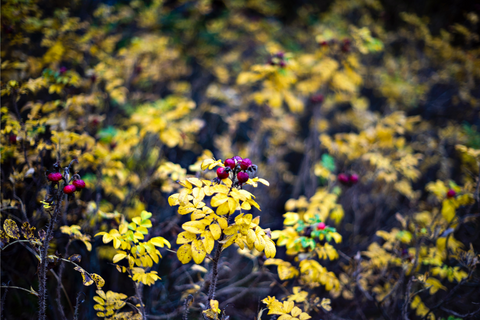The Rosehip Harvest


As the leaves begin to lose their grip and fall away, the autumn fruits of the hedgerows ripen and are ready to be found and foraged. Rowan, Blackthorn, Hawthorn, Elderberries, Crab Apple, Hazel, Blackberry, Raspberry to name but a few, all produce fruit and nuts now. Among the bounty is the humble rosehip, the ruby red fruit of the Dog Rose (Rosa canina) or the Field Rose (Rosa arvensis), which for our purposes are interchangeable.
Back in August I was smelling their perfume, which exists to attract pollinators to fertilise their flowers, the base of which then swells with seeds and forms the rosehip. They start to ripen at the end of summer, and can stay on the plant for a long time, well past the first frosts. They are at their best now, although ripening times of rosehips can vary even on a single plant. As long as there is no more green on the flesh, they are ready to harvest, which can be done with ease by hand, just avoid the thorns and simply twist them off the stems.
Rosehips are extremely nutritious and contain an enormous amount of vitamin C for their size, and because of this they were once relied upon by the whole country during and after World War Two when citrus fruit was unobtainable. Rosehips have since fallen out of favour in the pantry, possibly because they can be tricky to process as beneath the thin red and tangy flesh of this accessory fruit, the seeds are surrounded by irritating hairs. This is the rosehip's way of trying to avoid being eaten by animals with grinding teeth, which would destroy the seed, when it really wants to be eaten by birds, who can swallow the rosehip whole and deposit the seeds intact and far away from the parent plant.
A few weeks back I was lucky enough to celebrate the launch of the Menteath Wild Room, when I ventured to the south of England from my Scottish home. It was a wonderful evening, and at the end of it Felicity shared with me some of her hand crafted rosehip face oil. Her garden rose had produced a bumper crop of rosehips this year, and she created this beautiful daily face oil from her harvest. It is a special thing to create something you will use on your skin, grown or collected by your own hand, and I highly recommend it. In the spirit of giving, Felicity has shared her recipe for this glowing and warming oil with you and I.
Your Autumnal Rosehip Oil Blend
Here’s what you need:
-
Freshly picked or dried Rosehips - 1 cup
-
Pestle and mortar
-
Choice of oil - 500ml, I have used a combination of wheatgerm, hazelnut, camellia seed and macadamia
NOTE: I had some oils that I wanted to use up in the pantry and this blend worked very well as a super cocoon of 24 hydration and glowing skin… however, Sweet Almond is a great base oil for anyone new to blending and easily accessible.
-
Slow cooker
-
Clean muslin
-
Storage jar - apothecary jar or sealed pouring jar/bottle with lid
Step by step guide to your home blend:
Bash the hips into a paste using pestle and mortar
Add them to your oil blend(s)
Mix and blend hips into your oil
Slow cook on very low heat for 8 hours
Strain oil into a container (apothecary jar) for storage using muslin
Leave in dark cool spot for another 8-12 hours
How to use your homemade oil:
Use at dawn and/or dusk after cleaning your skin with water - 3-5 drops massage into the hands and pat gently around the eyes, face, and neck.
In my experience Rosehip has been great for looking after my dry skin which I often get when the seasons change. Hips just have a fantastic reputation for hydrating and brightening skin and it really does reduce inflammation from irritated skin and spots. Rosehip oil has been used as a folk remedy to treat arthritis and joint pain and is a wonder fruit for tightening stretched skin, and as a cleanser.
*Avoid if managing diabetes*
*Avoid if allergic to nut or seeds*
So there you have it, a very special recipe which I truly hope you try your hand at. I for one was excited to discover a use for Rosehips I had not explored before, one that is so straightforward. One of the many things I love about this recipe is how simple, flexible, and forgiving it is; not much can go wrong here, and the results are just so divine. I use it in the evening, as I find this oil so relaxing, it really sets me up for bedtime as the nights draw in.


